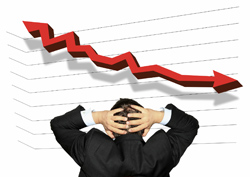 Would you invest in an asset that has been in the red for an entire decade? That’s the question a lot of investors have been asking themselves lately. The stock market rout that began in late 2008 and continued in early 2009 has resulted in a negative average annual return for stocks during the past 10 years, and that’s bound to make many people hesitate to commit the lion’s share of their portfolios to such a seemingly underwhelming investment. But the future for stocks looks much brighter than the recent—and not so recent—past. Would you invest in an asset that has been in the red for an entire decade? That’s the question a lot of investors have been asking themselves lately. The stock market rout that began in late 2008 and continued in early 2009 has resulted in a negative average annual return for stocks during the past 10 years, and that’s bound to make many people hesitate to commit the lion’s share of their portfolios to such a seemingly underwhelming investment. But the future for stocks looks much brighter than the recent—and not so recent—past.
Ten-year returns don’t exactly lie, but their story is much more complicated than you’d expect, according to a recent report from Vanguard Investment Counseling and Research—“The ‘Lost Decade’: Rational Expectations in Uncertain Markets,” by Francis M. Kinniry Jr. and Christopher B. Philips. Kinniry and Philips point out that during the past decade, the stock market has gone through several extraordinary periods—first, the runaway bull market of the late 1990s, then the brutal bear of 2000 through 2002, and finally the vertigo-inducing dive during late 2008 and early 2009. For years, the great markets of the late ’90s buoyed long-term performance numbers. But now, as they fall out of 10-year calculations, the results begin to look pretty bleak.
 For the decade ending June 1, 2009, the U.S. stock market as represented by the Standard & Poor’s 500 index returned a negative 3.32% a year—and that was after the market had rebounded almost 40% from its early March low. That’s worse than bonds, which had an average annual gain of 5.88% during the same period. But just a few years earlier, long-term stock performance looked much better, according to the Vanguard report. At the end of 2002, coming out of the most punishing bear market in 70 years, the 10-year average annual return for stocks was a respectable 8.74%, and just two years later, as 2004 came to a close, that average had risen to 11.92%. Three years later still, however, the average annual return for the preceding 10 years had plunged by almost half, to 6.29%. The reason? Returns from 1995 through 1997, three years during which annual gains averaged nearly 30%, had dropped out of the equation. For the decade ending June 1, 2009, the U.S. stock market as represented by the Standard & Poor’s 500 index returned a negative 3.32% a year—and that was after the market had rebounded almost 40% from its early March low. That’s worse than bonds, which had an average annual gain of 5.88% during the same period. But just a few years earlier, long-term stock performance looked much better, according to the Vanguard report. At the end of 2002, coming out of the most punishing bear market in 70 years, the 10-year average annual return for stocks was a respectable 8.74%, and just two years later, as 2004 came to a close, that average had risen to 11.92%. Three years later still, however, the average annual return for the preceding 10 years had plunged by almost half, to 6.29%. The reason? Returns from 1995 through 1997, three years during which annual gains averaged nearly 30%, had dropped out of the equation.
Those returns from the 1990s, though exceptional, came during a decade that saw average returns of almost 20% a year, according to the Vanguard report. That’s starkly different from the 2000s, which may well produce average annual returns of less than zero. Looking at those numbers, you might logically conclude that owning stocks isn’t what it used to be, and that you ought to pare back your portfolio’s equities, perhaps replacing them with bonds, which have outperformed all other asset classes so far this decade.
But that would be the wrong conclusion, suggest Kinniry and Philips. There’s nothing you can do about what has already occurred; what’s important for investors is what’s to come, and Vanguard, one of the world’s biggest fund managers, is decidedly bullish on stocks. Though equities are indeed riskier than bonds, that’s exactly why they tend to outperform fixed-income investments, and Vanguard’s analysts believe the current market offers a generous risk premium—the amount by which stock returns should exceed the return on “risk-free” Treasuries. Vanguard expects that during the next 10 years, stocks could potentially produce average annual real returns— net of inflation—of more than 9%.
The risk premium is based on the idea that for investors to take on stocks’ higher risks, they need the motivation of potentially higher returns. And the market’s recent volatility only drives home the point that stocks do bring real risks, and that short-term returns often fall as well as rise. From 1982 through 1999, there was only one down year in the stock market. But that was an anomaly, a departure from the stock market’s long history of producing a negative return one year in every four.
That fact, in turn, reminds investors of another truism—that to benefit from stocks’ long-term returns, you have to be in the market long term. If you sell when stocks fall, you will have paid the price of investment risk but you won’t be there for the gains that inevitably follow. To contain the risk of the market stumbling again before the next long-term bull market, a prudent strategy may be to “average” into the markets over the next six to 12 months, meaning that you should keep adding to your investments over time, rather than all at once.
Vanguard’s optimism about stocks is based on several factors. Even after the recent rally, price-to-earnings ratios remain relatively low, and though the economy may not recover quickly, the stock market typically rebounds well in advance of a return to economic growth. But there’s also the fact that stocks, statistically speaking, are due for a nice run after such a steep fall.* Investors miss it at their own peril. *Past performance is not a guarantee of future return. |